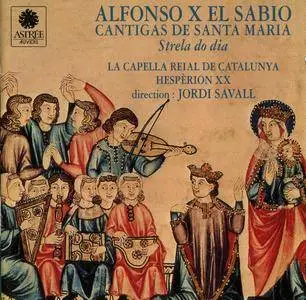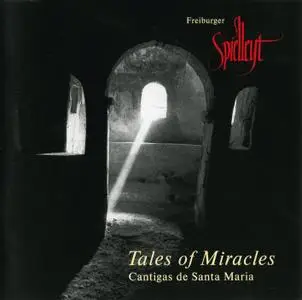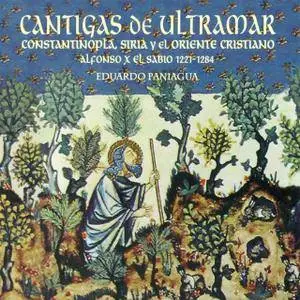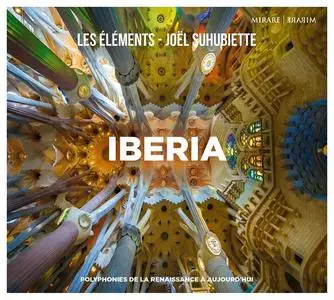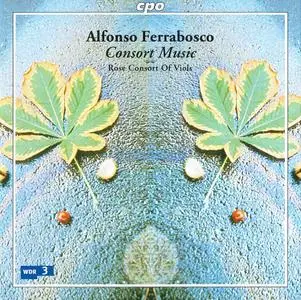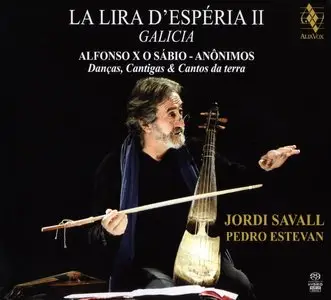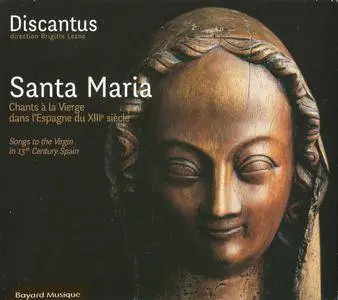Alfonso X
Alfonso X el Sabio - Miracle!: Cantigas de Santa Maria d'Alfonso el Sabio - Ensemble Obsidienne (2007) {Calliope CAL9366} Music
Posted by ruskaval at July 27, 2020
Alfonso X el Sabio - Miracle!: Cantigas de Santa Maria d'Alfonso el Sabio - Ensemble Obsidienne (2007) {Calliope CAL9366}
EAC rip (secure mode) | FLAC (tracks)+CUE+LOG -> 378 Mb | MP3 @320 -> 155 Mb
Full Artwork @ 300 dpi (png) -> 27 Mb | 5% repair rar
© 2007 Calliope / CAL 9366
Classical / Medieval / Early Music
In the thirteenth century, King Alfonso el Sabio (the wise), gathered together in his 'Cantigas de Santa Maria' four hundred songs (cantigas). These mystical, non-liturgical pieces were sung at various festivities, sometimes - as we see from the illuminated manuscripts - accompanied by dancing. Their form, verses with dialogue between texts and instruments, and so on. The 'Cantigas' involve celebration, dancing, storytelling, tales of miracles. The language used is Gallego-Portuguese, the language of lyric poetry at that time in the Iberian Peninsula.
Jordi Savall & Hesperion XX - Alfonso X El Sabio - Cantigas de Santa Maria (1993) {Astree-Auvidis E 8508} Music
Posted by ruskaval at July 4, 2017
Jordi Savall & Hespèrion XX - Alfonso X El Sabio - Cantigas de Santa Maria (1993) {Astrée-Auvidis E 8508}
EAC rip (secure mode) | FLAC (tracks)+CUE+LOG -> 309 Mb | MP3 @320 -> 164 Mb
Full Artwork @ 300 dpi (jpg) -> 112 Mb | 5% repair rar
© 1993 Auvidis / Astrée | E 8508
Classical / Medieval / Chamber Music
Jordi Savall, once more time, shares with us a beautiful program of instrumentals and chorals pieces from the middle age. Alfons X El Sabio Cantigas are the most popular music pieces about this period, but also really majestic. The sound of this album is really magic. A very good choice for a first approach…
Alfonso X el Sabio - Freiburger Spielleyt - Tales of Miracles (Cantigas de Santa Maria) (1994) {Verlag der Spielleute CD 9307} Music
Posted by ruskaval at June 5, 2020
Alfonso X el Sabio - Freiburger Spielleyt - Tales of Miracles (Cantigas de Santa Maria) (1994) {Verlag der Spielleute CD 9307}
EAC rip (secure mode) | FLAC (tracks)+CUE+LOG -> 312 Mb | MP3 @320 -> 142 Mb
Full Artwork @ 300 dpi (png) -> 11 Mb | 5% repair rar
© 1994 Verlag der Spielleute | CD 9307
Classical / Medieval / Neo-Medieval
Tales of Miracles — wonderful and magical stories from the Spanish Middle Ages based on the famous "Cantigas de Santa Maria". A colorful fusion of medieval and contemporary music reveals a distant dream-like world, whoise threatening specters and demons Maria defeats with her miraculous powers. The melting voices with historic, ethnic and electronic instruments imbues the Cantigas with a spirituality that trascends time.
Alfonso X el Sabio - Cantigas de Flandes (2009) {Pneuma} Music
Posted by tiburon at July 5, 2019
Alfonso X el Sabio - Cantigas de Flandes (2009) {Pneuma}
X Lossless Decoder | FLAC tracks | Cue+Log+M3U | Full Scans 300dpi | 430MB + 5% Recovery
MP3 CBR 320 Kbps | 134MB + 5% Recovery
Genre: Classical, Medieval
X Lossless Decoder | FLAC tracks | Cue+Log+M3U | Full Scans 300dpi | 430MB + 5% Recovery
MP3 CBR 320 Kbps | 134MB + 5% Recovery
Genre: Classical, Medieval
Alfonso X, called the Wise (Spanish: el Sabio), was the King of Castile, León and Galicia from 30 May 1252 until his death in 1284. During the election of 1257, a dissident faction chose him to be Roman-German king on 1 April. He renounced his claim to Germany in 1275, and in creating an alliance with England in 1254, his claim on Gascony as well. Alfonso X commissioned or co-authored numerous works of music during his reign. These works included Cantigas d'escarnio e maldicer and the vast compilation Cantigas de Santa Maria ("Songs to the Virgin Mary"), which was written in Galician-Portuguese and figures among the most important of his works. The Cantigas form one of the largest collections of vernacular monophonic songs to survive from the Middle Ages.
Alfonso X el Sabio - Cantigas de Ultramar - Music Antigua, Eduardo Paniagua (2017) {Pneuma Official Digital Download PN2-1530} Music
Posted by ruskaval at Feb. 9, 2018
Alfonso X el Sabio - Cantigas de Ultramar - Music Antigua, Eduardo Paniagua (2017) {Pneuma Official Digital Download PN2-1530}
FLAC (tracks) - 16bit/44kHz - Official Digital Download -> 696 Mb | MP3 @320 -> 302 Mb | Artwork | 5% repair rar
© 2017 Pneuma | PN2-1530
Classical / Early Music / Medieval
The CANTIGAS FROM OVERSEAS form part of Pneuma's project to record a retrospective of the entire collection of the Cantigas (medieval monophonic song) de Alfonso X and continue to explore the theme of miracles in the Eastern Mediterranean, completing CDs PN880 Cantigas of Byzantium, PN-1490 Cantigas of Rome, PN-1510 Cantigas of Alexandria and the future CD Cantigas of Jerusalem. Stories unfolding in Constantinople and Christian Syria, Rome and the Byzantine Empire (wise hermits and the Sufis from the East), give the impression of a travel novel packed with mystic teaching.
Joël Suhubiette, Les Éléments - Iberia: Polyphonies Espagnoles et Portugaises de la Renaissance à Aujourd’Hui (2018) Music
Posted by ArlegZ at Oct. 4, 2023
Joël Suhubiette, Les Éléments - Iberia: Polyphonies Espagnoles et Portugaises de la Renaissance à Aujourd’Hui (2018)
EAC | FLAC | Image (Cue & Log) ~ 302 Mb | Total time: 57:31 | Scans included
Classical | Label: Mirare | # MIR344 | Recorded: 2017
EAC | FLAC | Image (Cue & Log) ~ 302 Mb | Total time: 57:31 | Scans included
Classical | Label: Mirare | # MIR344 | Recorded: 2017
‘Iberia: Polyphonies Espagnoles et Portugaises de la Renaissance à Aujourd’Hui’ is a musical journey through time across the Iberian peninsula. From the medieval Spain of Alfonso The Wise to that of the Renaissance with Guerrero and Victoria, we are led to the Portugal of Lôbo and Cardoso, masters of the golden age of Portuguese polyphony. The voyage ends with two contemporary creations that continue this tradition, by the Portuguese António Chagas Rosa and the Spaniard Iván Solano.
The Dufay Collective - Music for Alfonso the Wise (2005) Music
Posted by ArlegZ at Oct. 3, 2024
The Dufay Collective - Music for Alfonso the Wise (2005)
EAC | FLAC | Image (Cue & Log) ~ 406 Mb | Total time: 71:08 | Scans included
Classical | Label: Harmonia Mundi | HMU 907390 | Recorded: 2002
EAC | FLAC | Image (Cue & Log) ~ 406 Mb | Total time: 71:08 | Scans included
Classical | Label: Harmonia Mundi | HMU 907390 | Recorded: 2002
Music for Alfonso the Wise by redoubtable English period instrument ensemble the Dufay Collective is not a collection of usual suspect Cantigas de Santa Maria, but attempts to re-create the lost heritage of the secular music that surrounded Alfonso X's court during his reign. Utilizing instruments reconstructed from miniatures, paintings, and other iconography dating from Alfonso's time, the Dufay Collective relies on music found within the Cantigas, manuscript sources outside it, remaining old musical practices still held over in "world music," and its own inventiveness to create an album that nonetheless smacks of authenticity.
Rose Consort of Viols - Alfonso Ferrabosco: Consort Music (2003) Music
Posted by ArlegZ at March 29, 2021
Rose Consort of Viols - Alfonso Ferrabosco: Consort Music (2003)
EAC | FLAC | Image (Cue & Log) ~ 375 Mb | Total time: 75:36 | Scans included
Classical | Label: CPO | # 999 859-2 | Recorded: 1997
EAC | FLAC | Image (Cue & Log) ~ 375 Mb | Total time: 75:36 | Scans included
Classical | Label: CPO | # 999 859-2 | Recorded: 1997
Under the single name, Alfonso, lie two composers, father and son. The strongest bond between them must have been composing; there was precious little else, since Ferrabosco the Elder fled England precipitously in the year his son and namesake was born. As viol players they had some influence on developments in their adoptive land. They are well known to viol players today, and what is presented here, with father and son in alternation, is of far more than academic interest.
Jordi Savall & Pedro Estevan - La Lira d'Esperia II: Galicia (2014) {Alia Vox AVSA9907} Music
Posted by ruskaval at Aug. 7, 2018
Jordi Savall & Pedro Estevan - La Lira d'Esperia II: Galicia (2014) {Alia Vox AVSA9907}
EAC rip (secure mode) | FLAC (tracks)+CUE+LOG -> 430 Mb | MP3 @320 -> 171 Mb
Full Artwork @ 600 dpi (jpg) -> 392 Mb | 5% repair rar
© 2014 Alia Vox | AVSA9907
Classical / Chamber Music / Medieval
Exactly 20 years ago (in 1994), after several years of research, experimentation and concerts, we recorded our first CD devoted to La Lira d’Espéria, performed on my three early instruments – the Rebec, the Tenor Fiddle and the Rabab (Rabel morisco) – with the indispensable percussion of Pedro Estevan. The idea was to announce the music and instruments featured in the recording using the evocative ancient names of Lyra and Hesperia. It was an obvious choice, as the whole recording was devoted to the medieval repertory for bowed instruments and consisted of music from the various Christian, Jewish and Arabo-Andalusian cultures that existed in ancient Iberia and Italica.
Ensemble Discantus - Santa Maria: Songs to the Virgin in 13th Century Spain (2016) {Bayard Musique 308 489.2} Music
Posted by ruskaval at Aug. 16, 2020
Ensemble Discantus - Santa Maria: Songs to the Virgin in 13th Century Spain (2016) {Bayard Musique 308 489.2}
EAC rip (secure mode) | FLAC (tracks)+CUE+LOG -> 298 Mb | MP3 @320 -> 143 Mb
Full Artwork @ 600 dpi (jpg) -> 54 Mb | 5% repair rar
© 2016 Bayard Musique / Harmonia Mundi | 308 489.2
Classical / Early Music / Medieval / Choral
A program that gives pride to the famous collection of Cantigas de Santa Maria, Galician songs recounting legends and miracles of the Virgin, alternating with Marian songs of the troubadours Guiraut Riquier and Folquet Lunel (longtime present at the Alfonso X king's court) and polyphonies from the exquisite codex Las Huelgas.

